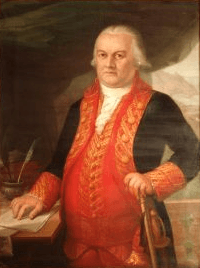Gregorio García de la Cuesta facts for kids
Quick facts for kids
Gregorio García de la Cuesta
|
|
|---|---|
 |
|
| Birth name | Gregorio García de la Cuesta y Fernández de Celis |
| Born | 9 May 1741 La Lastra, Spain |
| Died | 1811 (aged 69–70) |
| Allegiance | |
| Battles/wars | War of the Pyrenees
|
Gregorio García de la Cuesta (born May 9, 1741 – died 1811) was an important Spanish general. He played a big role in the Peninsular War, a major conflict in Spain.
Contents
Early Military Career
Gregorio García de la Cuesta was born in La Lastra, a town in Cantabria, Spain. His family were minor nobles. In 1758, when he was 17, Cuesta joined the military. He became a member of the Spanish Royal Guards Regiment.
Successes in the Pyrenees War
Cuesta showed his skills as a military leader during the War of the Pyrenees (1793-1795). He was a Lieutenant General and achieved several victories. On December 20, 1795, he led 8,000 Spanish and Portuguese soldiers. They successfully attacked and captured the French towns of Collioure, Port-Vendres, and Fort Saint-Elme. Cuesta's forces defeated 4,000 French defenders.
He also led a group of soldiers under General José de Urrutia y de las Casas. They won the Battle of Bascara on June 14, 1795. A month later, on July 26, Cuesta's troops captured 1,500 French soldiers at Puigcerdà. The next day, he took the town of Bellver and its 1,000 French soldiers. These victories happened just after a peace treaty was signed on July 22, 1795. Because of political issues, Cuesta did not get promoted further until 1805. At that time, he was made the Commander in Chief of the Army of Castile.
The Peninsular War Begins
In 1808, war broke out between Spain and France. Cuesta was 67 years old. At first, he did not want to lead the people who were rebelling in Valladolid. But the people threatened him, and he agreed to lead.
Challenges and Defeats
Cuesta's army was not well-prepared. It was made up of about 5,000 hastily recruited soldiers. They were not well-trained or equipped. This army had little chance against Napoleon's powerful French army. Cuesta's forces were badly defeated at the Battle of Cabezón. This loss forced him to leave Valladolid.
After this, Cuesta combined his remaining soldiers with Lieutenant General Blake's Army of Galicia. Cuesta, being the senior general, insisted on marching towards Valladolid. This decision left their combined army open to a French attack. Because the two generals did not work well together, they were defeated on July 14 at the Battle of Medina de Rioseco. Cuesta failed to keep his troops close to Blake's, which led to their loss.
Brief Command and Arrest
Cuesta then talked with the Central Junta, which was the Spanish government. He was briefly promoted to Commander-in-Chief of the Spanish Army. However, there was no clear military plan or way to work with other Spanish forces. Soon, Cuesta was removed from his position and arrested due to political disagreements.
Return to Command
After the French captured Madrid at the Battle of Somosierra, the situation in Spain became very serious. Cuesta was allowed to rebuild the Army of Extremadura. His job was to protect the southern border of Spain. Cuesta decided to attack the French as soon as he had a fighting force. This plan worked well. In January and February 1809, the Spanish army took back all of Badajoz from the French.
However, Cuesta was not given enough supplies or new soldiers. Local officials wanted to review the appointments he had made in the army first. Because of this, a French attack in the spring took back all the land Cuesta had gained. On March 26, Cuesta was badly wounded at the Battle of Medellín. He was trampled by cavalry, and his army suffered a terrible defeat. Even though he was injured, he continued to fight.
Working with British Allies
Cuesta later joined forces with the British army led by Wellington. Their relationship was difficult. Cuesta often promised supplies to the British but failed to deliver them, which annoyed Wellington. More problems arose after the Battle of Talavera. The Anglo-Spanish army won this battle, but it was very costly. Wellington wanted to retreat to stop French General Nicolas Soult from cutting off his path to Portugal. Cuesta refused to cooperate. Wellington was also very angry when Cuesta left injured British soldiers behind, allowing them to become French prisoners.
Cuesta continued to fight the French without coordinating with his allies. This led to more Spanish defeats. In 1810, Cuesta suffered a serious stroke. He retired from the military and died a year later in 1811.
See also
 In Spanish: Gregorio García de la Cuesta para niños
In Spanish: Gregorio García de la Cuesta para niños

